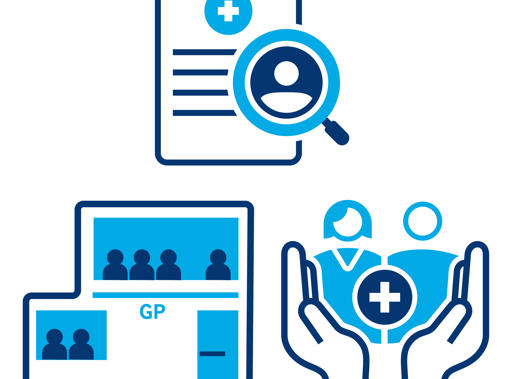This guide is designed to help GP practices make decisions that will allow them to prioritise their limited capacity to deliver safe, high-quality care. GPC England recommends you can do this by reviewing your currently offered services. Decisions will need to be individualised to the needs of your patients and practice. This approach recognises practices are operating within limited resources, but also the need to stay within the requirements of the GMS/PMS contract.
By introducing the BMA’s Safeworking Guidance: a handbook for General Practice, in the majority of practices the number of offered appointments each day will fall. This means some patients with non-urgent problems may have to wait longer, but the priority is to ensure those patients that are seen receive safe care within your limited capacity to provide this. There will be times when patients will need to be directed to more appropriate alternative services than are available at the practice. Overall, the steps we outline will allow your practice to devote its resources to those patients it is best placed to help.
You can also view our resources to download and share here.
Safe working guidance: a handbook for general practice in England
We have also created letters to pushback against external un-resourced workload:
Background and context
General practice is in crisis. GPs are faced with increasingly unsafe workloads coupled with a rapidly diminishing and exhausted workforce. Structural underinvestment in General Practice and an ever reducing share of the total NHS spend, coupled with hospital workload transfer and the ongoing impact of the Covid-19 pandemic, have generated a vast backlog of care. This is creating further pressure on a system that is already at breaking point.
GPC England has agreed to the 2025/26 GMS contract coming into effect on 1 April 2026. We are now determining the next steps on both this contract and the Government’s commitment to a new substantive contract. In the mean time, GPC England encourages all LMCs to promote and support practices in their implementation of the BMA Safe Working Guidance.
Understanding recent trends
The nation’s population and demographics are changing, with more complexity and comorbidities. The number of patients each GP is now responsible for has been steadily rising, with the average number of patients each GP takes care of increasing by nearly 17% since 2015 to 2,295. The Family Doctor Charter of 1965 and 1966 GP Contract introduced a limit of 2,000 patients per GP, recognising the need for effective workload management as a basis for the delivery of safe, high-quality patient care.
Worryingly, despite the undeniable need for more GPs, increasingly GPs are leaving the NHS, or reducing their NHS and practice-based commitments. More recent reports show GPs facing unemployment or under-employment. This is caused by the lack of appropriate investment in General Practice. There are now only 0.44 fully qualified GPs per 1,000 patients in England – down from 0.52 in 2015.
GPs and practices are now seeing nearly half the of the country’s population every month: NHS data shows more than 29.9 million appointments (excluding vaccinations) were delivered by GP practices in March 2024. The majority of GP appointments are face-to-face. Consultation rates per patient have increased. This is unsurprising given changing population demographics and the fact that multiple morbidity is more common.
Patients want and need to see GPs, but the current situation means that we have fewer and fewer GPs working in GP practices. At a time when we need to be focusing on prevention and holistic health care, the priority should be on recruiting and retaining all GPs throughout their careers so that they can deliver the best care for patients, closer to their homes and communities.
Not enough GPs means that fewer GPs are providing care for more patients. This is a vicious spiral. It increases the risk of suboptimal care through decision fatigue. It also risks GPs becoming demoralised, unwell and predisposed to moral injury. The NHS then risks hard working and committed colleagues being lost to the profession altogether.
Access versus Capacity: Record breaking appointments
GPs and practices are seeing nearly half the of the country’s population every month. The great majority of GP appointments are face-to-face and contact rates per patient have increased.
Practices are offering record breaking numbers of appointments, regularly exceeding their capacities in a bid to try and keep up with demand. Cambridgeshire LMC’s General Demand and Capacity survey from 2021, revealed that once capacity was full, GPs and practices would continue to add extra patients for them to be seen. This is not safe, sustainable, and does not enable us to deliver high quality care.
Inadequate Practice Resourcing/Investment
Despite the massive inflationary increases and financial squeeze, practices were only offered 1.9% in the latest 2024/25 imposed contract, which in real terms represents a cut in funding. Practices are struggling due to inadequate core funding which is no longer sufficient to cover workforce and salary costs.
Over £1.4 billion pounds per year has been committed for roles working within PCNs (primary care networks (PCNs) as part of the ARRS (Additional Roles Reimbursement Scheme (ARRS). However, a situation has been created whereby despite:
- patients wanting to see GPs
- GPs wanting to take up roles within practices
- and practices wanting to employ GPs.
The recent changes to the NHSE ARRS funding rules, allowing an expansion of the scheme, will not address the problem of GP unemployment.
Patient satisfaction has continued to drop, as the number of patients per GP has increased. The current situation is not tenable.
Burn Out and Well Being
Not enough GPs means that fewer GPs end up providing care for more patients. The never ending ‘hamster wheel’ of continually trying to keep up with demand, can increase the risk of harm and suboptimal care through decision fatigue. It also risks GPs becoming unwell and burned out, leading to them being lost to the profession altogether. bma-moral-distress-injury-survey-report-june-2021.pdf
Working in over stretched and pressured environments can make people feel powerless, undermining their sense of self control, self-determination and agency.
This is particularly striking when it feels as if key decisions and choices are made by others. Moral distress is the feeling of being forced to compromise oneself and ethical beliefs, due to external forces seemingly beyond one’s own control and this can lead to moral injury, and harm to the individual. We cannot afford to lose any more GPs, and need to ensure that the working environment enables us to retain people within the workforce.
What needs to happen next
Empowerment
GPs and practices need to regain and retain their sense of agency, self-determination, and autonomy, to create the head space and capacity to deliver safe, high quality patient care. As highly trained and committed members of the practice team, serving the local population, GPs and practices are well placed to work with their patients and communities to help design and deliver the services required. This can be guided by the needs of the patients, community, GPs, staff, and practice within the framework of the General Medical Services contract.
GPs and practices need to control the speed of their hamster wheel.
This can be achieved through using the BMA Safe Working and Workload Control Guidance and BMA GP Practice Survival Toolkit recommendations:
- Workload control
- Reorganise practice services
- Collective action
Resources
Download, share and display social media graphics and posters for your surgery.
Social media graphic (for GPs)
Social media graphics (patient facing):
- GP safe working graphic 1
- GP safe working graphic 2
- GP safe working graphic 3
- GP safe working graphic 4
- GP safe working graphic 5
- GP safe working graphic 6
Posters:

We know how it is to be on the frontline of healthcare. That's why we provide advice and a myriad of resources for GPs, no matter what you might be facing, free mediation if things get difficult, as well as confidential 24/7 counselling and wellbeing support.
Resources
- Guidance on imposed 2024/25 GP contract changes

